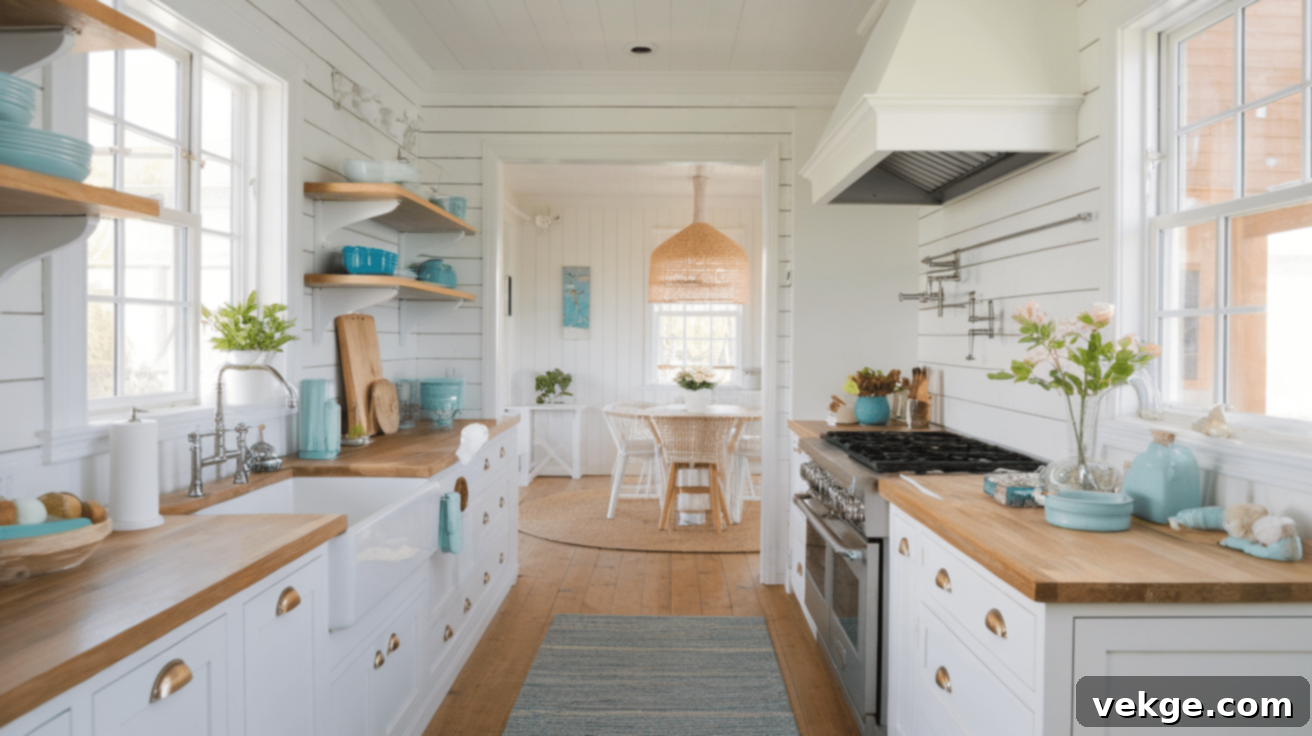Coastal Farmhouse Kitchen Design: Your Ultimate Guide to Creating a Bright & Cozy Space
The coastal farmhouse kitchen style beautifully merges the refreshing, open feel of a beach house with the comforting, lived-in warmth of a traditional country home. This unique fusion results in kitchens that are not only inviting and practical but also exude a timeless charm. Characterized by clean white foundations, subtle hints of sea blue, natural wood elements, and thoughtfully chosen textures, these kitchens have become a coveted choice for homeowners seeking a space that is both aesthetically pleasing and highly functional.
As the popularity of this relaxed and enduring style continues to grow, more people are drawn to its serene aesthetic and welcoming ambiance. This comprehensive guide will walk you through every essential step, providing you with the knowledge needed to create, maintain, and truly enjoy your very own coastal farmhouse kitchen.
Key Elements of Coastal Farmhouse Kitchen Design
The harmonious blend of coastal and farmhouse aesthetics creates kitchens that feel simultaneously fresh, bright, and wonderfully lived-in. This dynamic combination brings together the light, airy quality often found in beach-inspired interiors with the rustic warmth synonymous with country homes, forming spaces perfect for family gatherings, everyday cooking, and effortless entertaining.
Let’s delve into the fundamental components that make these kitchens exceptionally appealing and highly functional.
Color Palettes for a Coastal Farmhouse Kitchen
Soft whites serve as the foundational color in most coastal farmhouse kitchens, acting as a canvas that maximizes natural light and enhances the room’s spaciousness. To introduce that essential coastal touch, various shades of sea blue are integrated, ranging from delicate aqua tones to deeper navy accents. These blues can appear on islands, backsplashes, or through decorative elements. Sandy neutrals, such as warm grays, light browns, and creamy beiges, are crucial for grounding the space and adding an inviting warmth, preventing the overall look from feeling too stark.
For a beautifully balanced aesthetic, aim to select two primary colors complemented by a range of neutrals. Matte finishes are generally preferred over glossy ones, as they contribute to the relaxed, homey atmosphere. Carefully consider how your chosen colors will be distributed across different surfaces—from expansive walls and cabinetry to smaller, impactful details like bar stools or window treatments.
Materials & Textures: Building Depth and Character
Shiplap walls are a hallmark of this style, instantly infusing a room with coastal character and a subtle textural interest. Reclaimed wood elements, such as exposed ceiling beams, a robust island base, or sturdy open shelving, introduce depth, history, and an authentic farmhouse feel. Driftwood-toned floors, with their naturally weathered appearance, perfectly tie together both the rustic and oceanic aspects of the design.
Hardware choices are also critical: unlacquered brass, which develops a beautiful, rich patina over time, perfectly complements the relaxed and aged charm of this style. Woven accents, like rattan pendant lights, seagrass baskets for storage, or jute rugs, add organic texture and a natural, tactile quality. Linen fabrics, used for window treatments, upholstery, or even dishtowels, contribute a soft, casual elegance.
The secret to a successful coastal farmhouse kitchen lies in mixing textures thoughtfully. Pair smooth, refined surfaces such as marble or quartz countertops with rough-hewn wooden beams, or juxtapose sleek, modern appliances with subtly textured backsplash tiles for a dynamic and visually engaging space.
Layout & Design Features: Functionality Meets Style
Open shelving is a popular feature, allowing homeowners to display curated dishware and decor while maintaining an airy, unencumbered feel. Exposed beams not only add significant architectural interest and farmhouse character but also draw the eye upward, making the space feel taller and more expansive.
The iconic farmhouse sink, with its deep basin and apron front, serves as both a highly functional workspace and a prominent style statement. Kitchen islands are central to these kitchens, acting as versatile gathering spots for family and friends, as well as providing ample additional workspace. Consider an island painted in a contrasting color with a durable butcher block countertop for added warmth and utility.
When planning your layout, prioritize good traffic flow, especially in these family-centric kitchens. Smart storage solutions that discreetly hide modern appliances are key to preserving the timeless, uncluttered aesthetic that the coastal farmhouse style aims to achieve, allowing the design elements to shine.
Step-by-Step Guide for Creating Your Coastal Farmhouse Kitchen
Embarking on the journey to create a coastal farmhouse kitchen requires meticulous planning and a clear vision. By following these structured steps, you can seamlessly blend the breezy elements of a beach home with the comforting essence of country living, resulting in a space that is both highly functional and visually stunning.
Step 1: Start with Layout
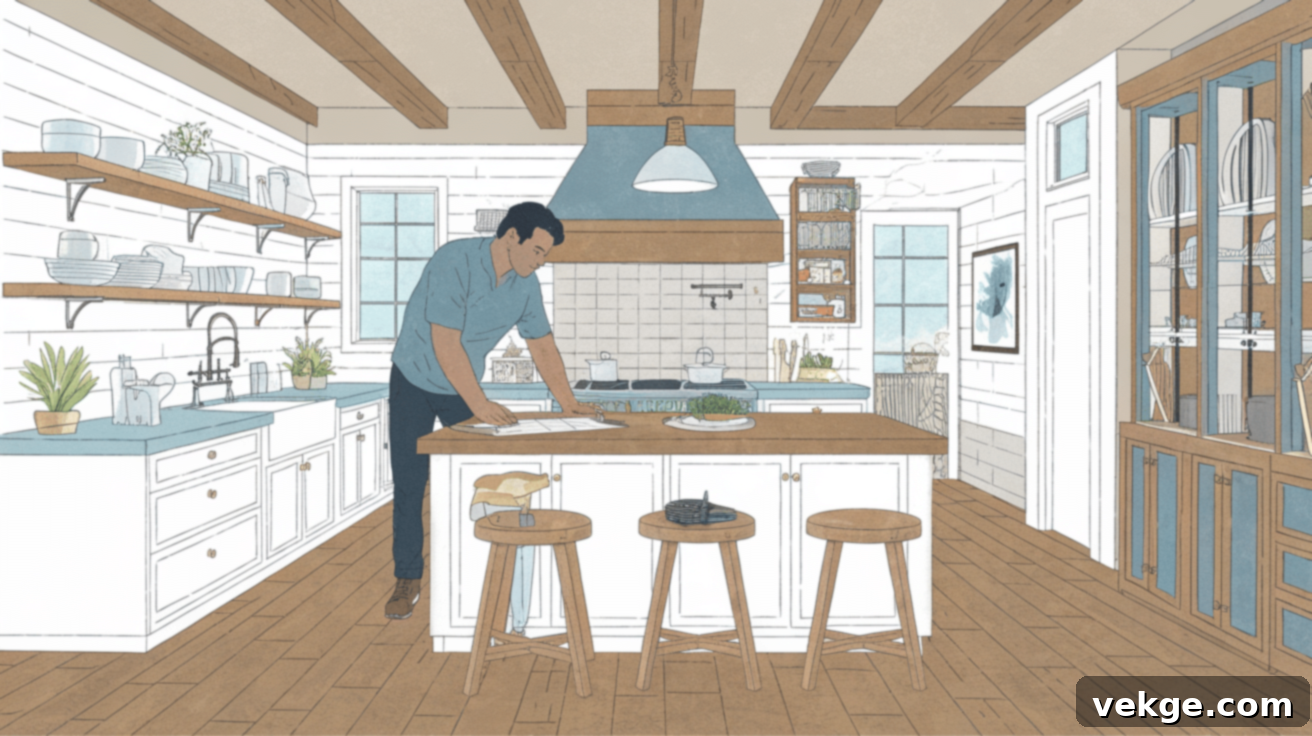
Begin by mapping out your kitchen space, either on paper or using a digital design tool. This initial step is crucial for accurately determining the exact placement of key features like open shelves, the sink, major appliances, and the kitchen island. Pay close attention to the “work triangle” (refrigerator, sink, stove) and ensure efficient movement between these areas.
Carefully measure walking paths; you’ll need at least 36 inches for primary walkways and a more generous 42-48 inches if multiple cooks will be using the kitchen simultaneously. Envision how you and your family will navigate the kitchen during daily routines and entertaining. Consider whether you need an unobstructed path from the refrigerator to the sink and then to the stove. Identify and eliminate potential bottlenecks, especially near dishwasher or refrigerator doors. Additionally, plan sight lines from adjacent dining and living areas to ensure your kitchen presents a cohesive and attractive view from all angles.
Step 2: Pick Your Perfect Color Palette

Select a harmonious palette of soft whites, calming sea blues, and rich, warm wood tones as the core foundation for your kitchen. Start with a clean white base for your walls and cabinets, which will make the space feel bright and expansive. Excellent paint options often recommended in home design tours include Benjamin Moore’s White Dove or Sherwin Williams’ Alabaster.
Introduce coastal charm by incorporating blue tones on features like a kitchen island, a backsplash, or even smaller appliances and accessories. Wood elements—such as exposed ceiling beams, robust open shelving, or durable flooring—are essential for bringing necessary warmth and visual balance to the overall design. Remember to take the time to sample your chosen colors directly in your actual space. Observe how they appear under various lighting conditions throughout the day—morning, afternoon, and evening—before finalizing your decisions to ensure they create the desired ambiance.
Step 3: Select Signature Materials
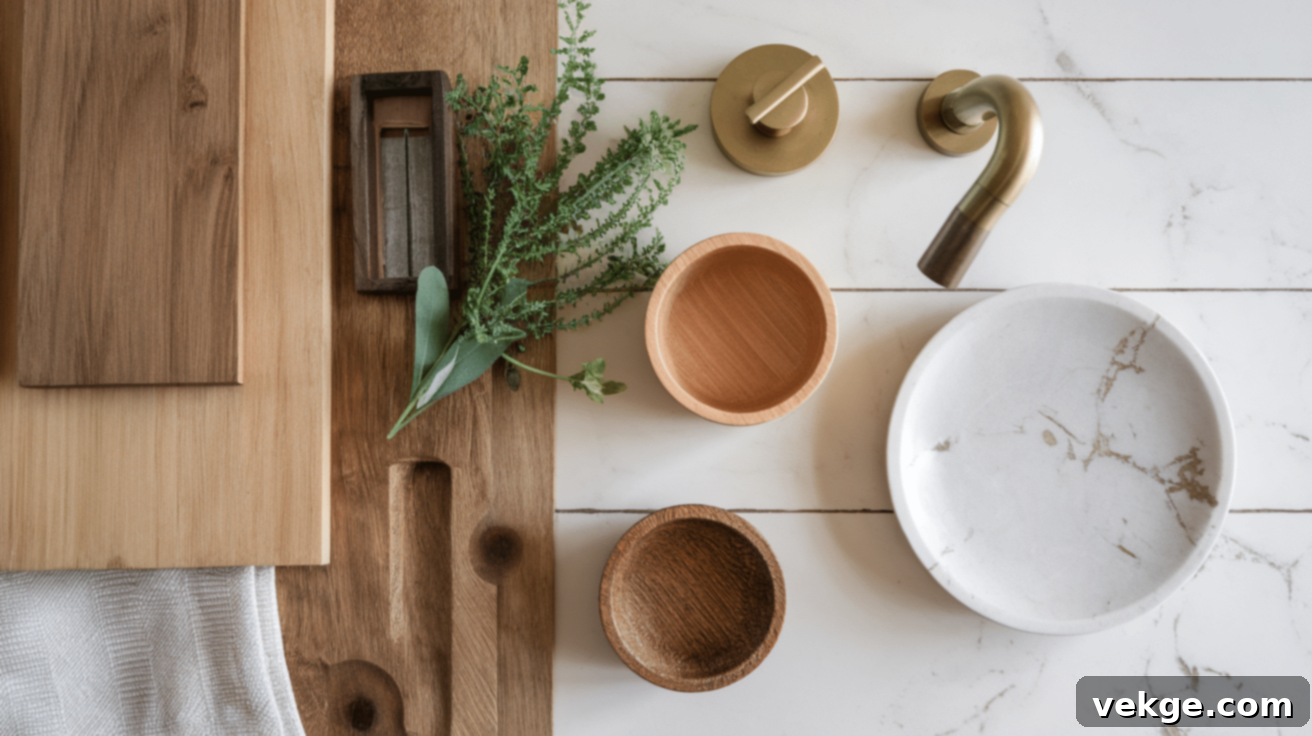
To truly define your coastal farmhouse kitchen, focus on signature elements that embody the style. Install classic shiplap on walls, a kitchen island, or even as an accent ceiling for immediate texture and character. Opt for driftwood-toned flooring that features natural variations, mimicking the weathered beauty of coastal environments. For hardware and fixtures, select unlacquered brass; this material will naturally develop a unique patina over time, adding a layer of authenticity and warmth to your space.
Create visual interest and contrast by skillfully mixing smooth surfaces, such as polished marble or sleek quartz countertops, with textured elements like woven pendant lights or artisan backsplash tiles. It’s vital to remember that kitchens endure heavy daily use. Therefore, select materials for high-traffic areas that are not only beautiful but also robust enough to withstand moisture, heat, and everyday wear and tear, ensuring their beauty and functionality for years to come.
Step 4: Add Key Features and Focal Points
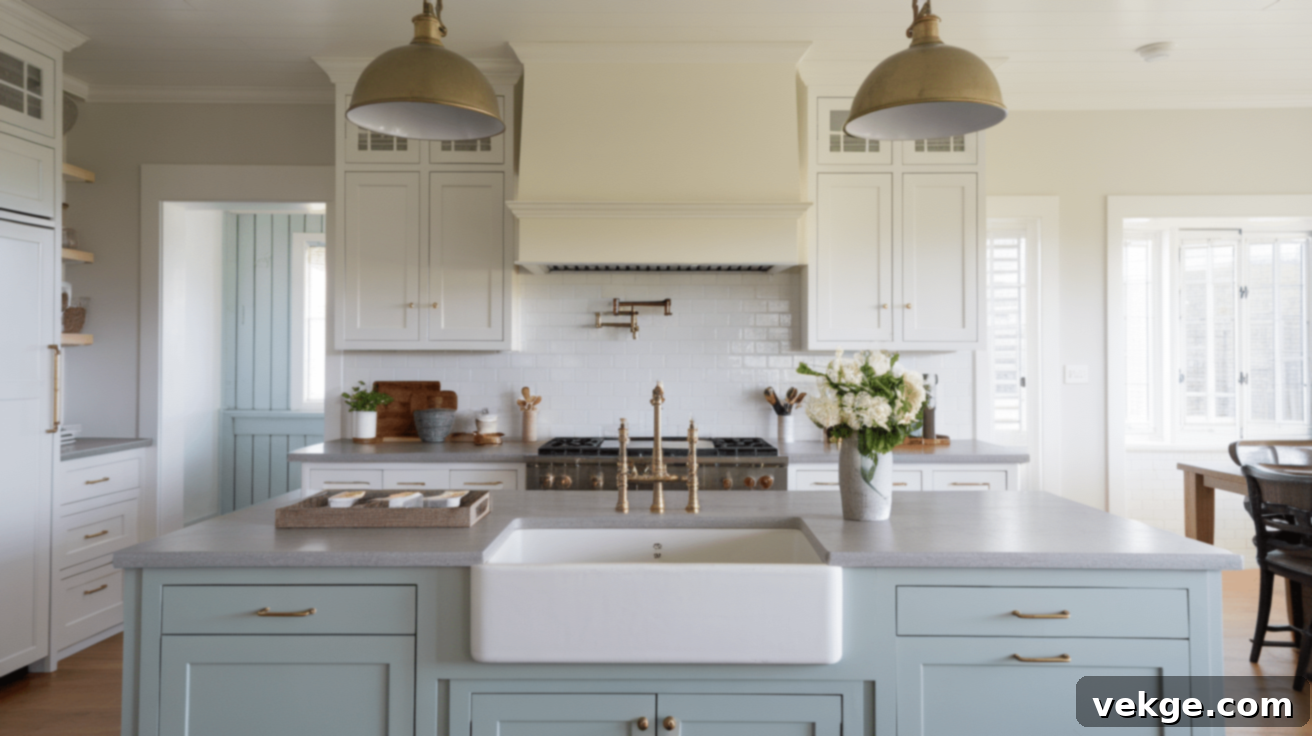
Integrate statement pieces that serve as anchors for your chosen style. A large, white apron-front farmhouse sink is often the heart of this kitchen style, acting as a prominent focal point. These deep, practical basins are not only aesthetically pleasing but also incredibly functional for washing large pots and pans. Beyond the sink, carefully consider your lighting scheme, which should be layered for optimal functionality and ambiance. Include pendant fixtures above islands or sinks—options like rattan or simple brass designs work wonderfully for both task lighting and aesthetic appeal. Supplement this with under-cabinet task lighting for preparing food and warm ambient lighting to illuminate the overall space, creating a welcoming glow.
Step 5: Decorate Thoughtfully and Minimally

When decorating, select accessories that serve a dual purpose of both function and style. Woven baskets placed on open shelves provide practical storage for pantry items or linens while adding texture. Use linen dish towels and napkins, stored neatly in drawers or displayed, for a touch of casual elegance. Introduce small, subtle beachy accents, such as a jar filled with sea glass, a decorative piece of driftwood, or rustic wooden cutting boards.
Instead of cluttering every available surface, adopt a “less is more” approach. Group similar items in odd numbers, typically threes, to create visually pleasing vignettes. Ensure there’s ample open space on shelves and countertops to allow the eye to rest and to maintain an airy feel. Prioritize larger, impactful statement pieces over an abundance of small, busy items. As exemplified by blogs like The Harper House, even a few thoughtfully chosen items can perfectly convey the desired aesthetic without overwhelming the space.
Step 6: Plan for a Realistic Budget
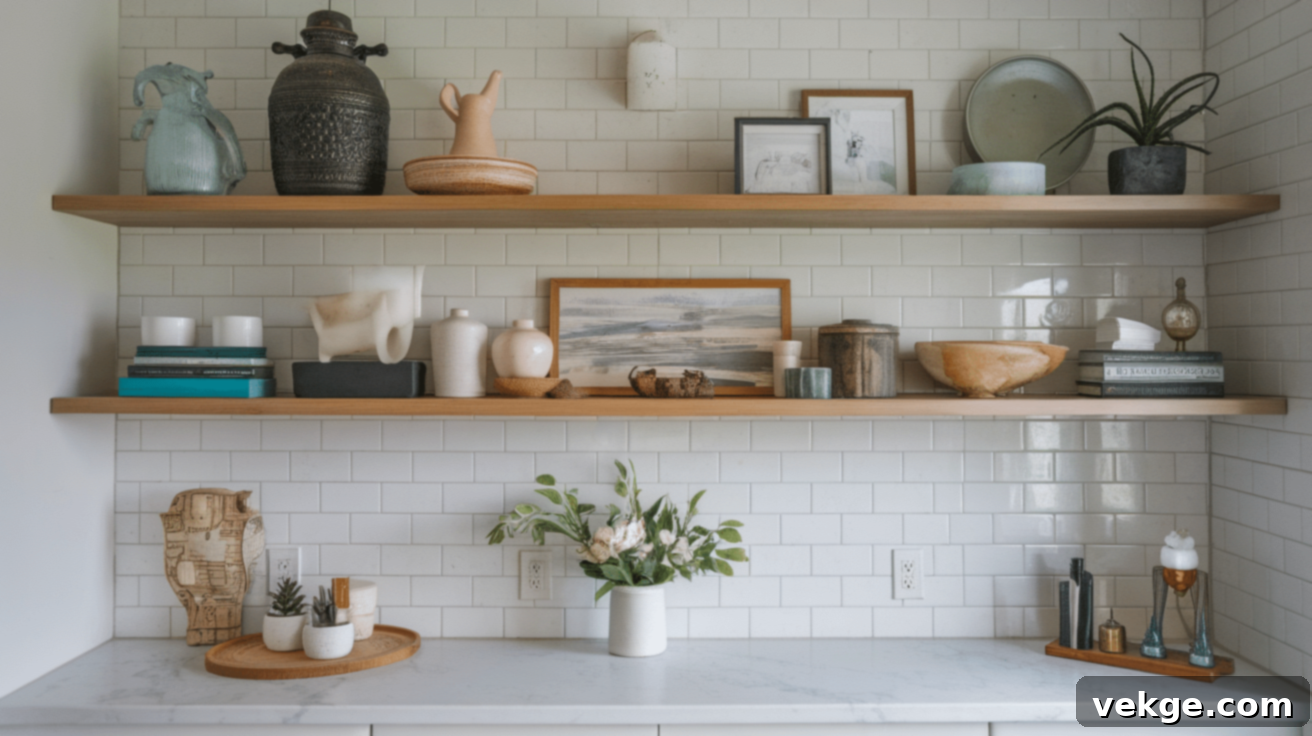
Develop a detailed spending plan that clearly prioritizes your investments. Allocate a larger portion of your budget to items you interact with and use daily, as quality in these areas will yield long-term satisfaction. This includes durable cabinet hardware, resilient countertops that can withstand heavy use, and reliable fixtures. Investing wisely in these core elements will pay off significantly in terms of longevity and everyday enjoyment.
Conversely, aim to save on elements that can be easily updated or replaced later, such as wall paint, decorative accessories, or even certain lighting fixtures. Keep an eye out for sales on major appliances, and consider floor models or discontinued lines for substantial savings without compromising quality. Mix new purchases with charming vintage finds from thrift stores, antique shops, or online marketplaces. These items can often be refreshed with a coat of paint or new hardware, adding unique character and a sense of history to your kitchen while helping to keep overall costs down.
Small Kitchen Solutions for Coastal Farmhouse Style
Even in compact spaces, it’s entirely possible to capture the delightful charm of coastal farmhouse design with clever planning and resourceful solutions. Maximizing every inch is key to creating both beauty and functionality in a smaller footprint.
- Rolling Islands: Consider a mobile kitchen island that can be moved or tucked away when additional floor space is needed. This provides flexible prep and serving areas.
- Wall-Mounted Storage: Utilize vertical space with wall-mounted pot racks and magnetic knife strips to free up precious counter space, keeping essential tools easily accessible.
- Compact Farmhouse Sink: A smaller, single-bowl apron-front farmhouse sink can fit comfortably in tighter layouts, still delivering the signature aesthetic without dominating the counter.
- Light Color Palette: Employ light colors, especially whites and soft blues, on walls and cabinetry to make tight spaces feel significantly larger, brighter, and more open.
- Glass-Front Cabinets: Install glass-front cabinet doors or consider removing some upper cabinet doors entirely to create a sense of openness and airiness, breaking up solid wall lines.
- Vertical Storage: Make the most of wall height with narrow shelving units, floor-to-ceiling pantry solutions, or simple hooks for frequently used items like mugs or utensils.
- Multi-Purpose Furniture: Opt for furniture pieces that offer hidden storage or serve multiple functions. Examples include benches with built-in compartments for seating and storage, or islands designed with open shelving underneath for displaying attractive items or housing bins.
Styling Tips for Your Coastal Farmhouse Kitchen
Crafting the perfect coastal farmhouse kitchen involves a thoughtful curation of details that seamlessly blend both design styles. The core principle is achieving balance—mixing the casual, breezy elements of beach living with the warm, inviting touches of country comfort. With a few careful choices, you can build a space that feels both fresh and enduring, embodying the relaxed comfort that makes this style so universally adored.
1. Mix Wood Tones
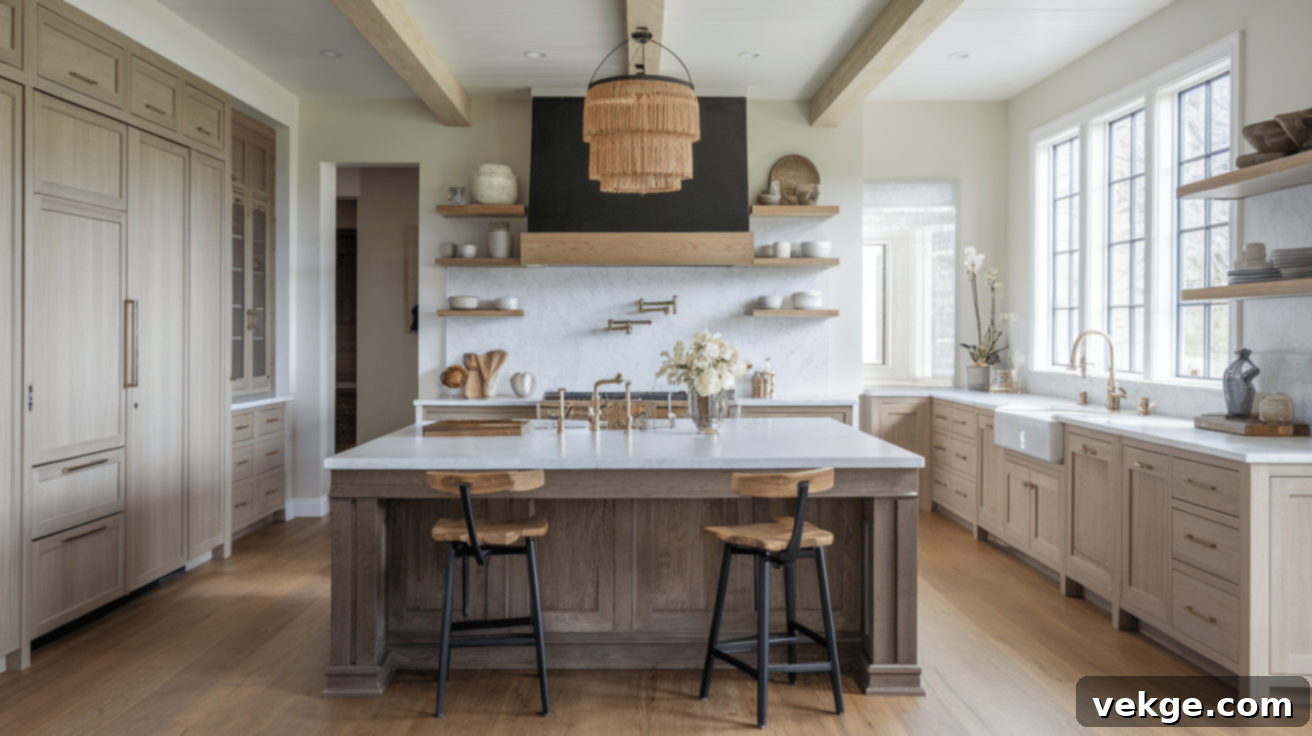
Blend different light and medium wood finishes throughout your kitchen to introduce warmth, depth, and a natural, organic feel. For instance, pairing lighter white oak or maple cabinetry with darker walnut accents in an island top or shelving creates visual interest while maintaining the bright, airy quality essential to coastal design. Consider incorporating wooden beams on the ceiling or selecting a statement kitchen island in a rich, contrasting wood tone to add significant character and definition.
2. Keep Decor Simple and Curated
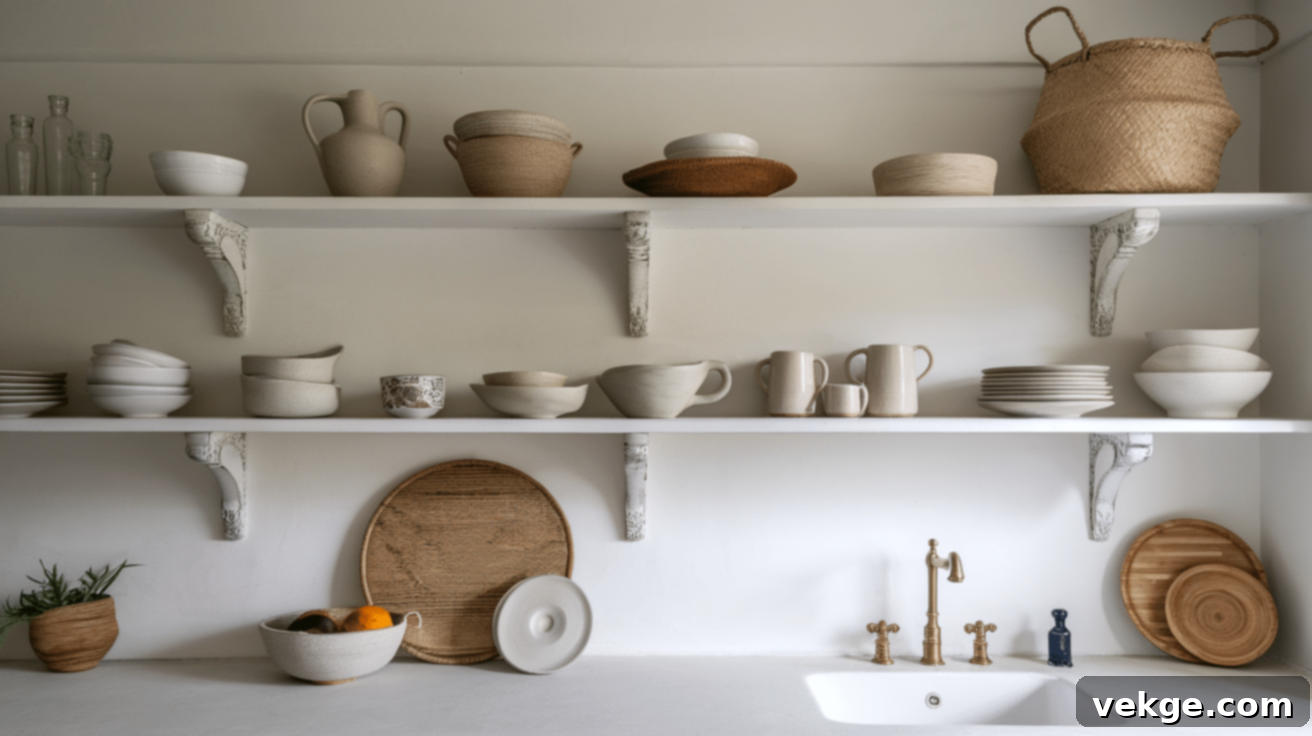
Utilize open shelves as an opportunity to display a carefully curated collection of items, such as neutral ceramics, clear glass jars for pantry staples, or stylish woven baskets. Choose decorative pieces primarily in whites, creams, soft blues, and natural wood tones that serve both functional and aesthetic purposes. It’s crucial to limit the number of objects to prevent visual clutter; the ultimate goal is a clean, organized look that allows each element to breathe and contribute to the serene atmosphere.
3. Layer Textures for Depth

Introduce a variety of textures to add depth, softness, and visual intrigue to your space. Consider linen tablecloths, plush wool rugs, and jute accents like placemats or trivets. Natural fibers are excellent for seamlessly bringing both the coastal and farmhouse styles together. Think about adding a sisal runner in a high-traffic area, using soft cotton tea towels, and placing woven seat cushions on bar stools to enhance comfort while maintaining the casual, lived-in quality inherent in this design approach.
4. Focus on Thoughtful Lighting
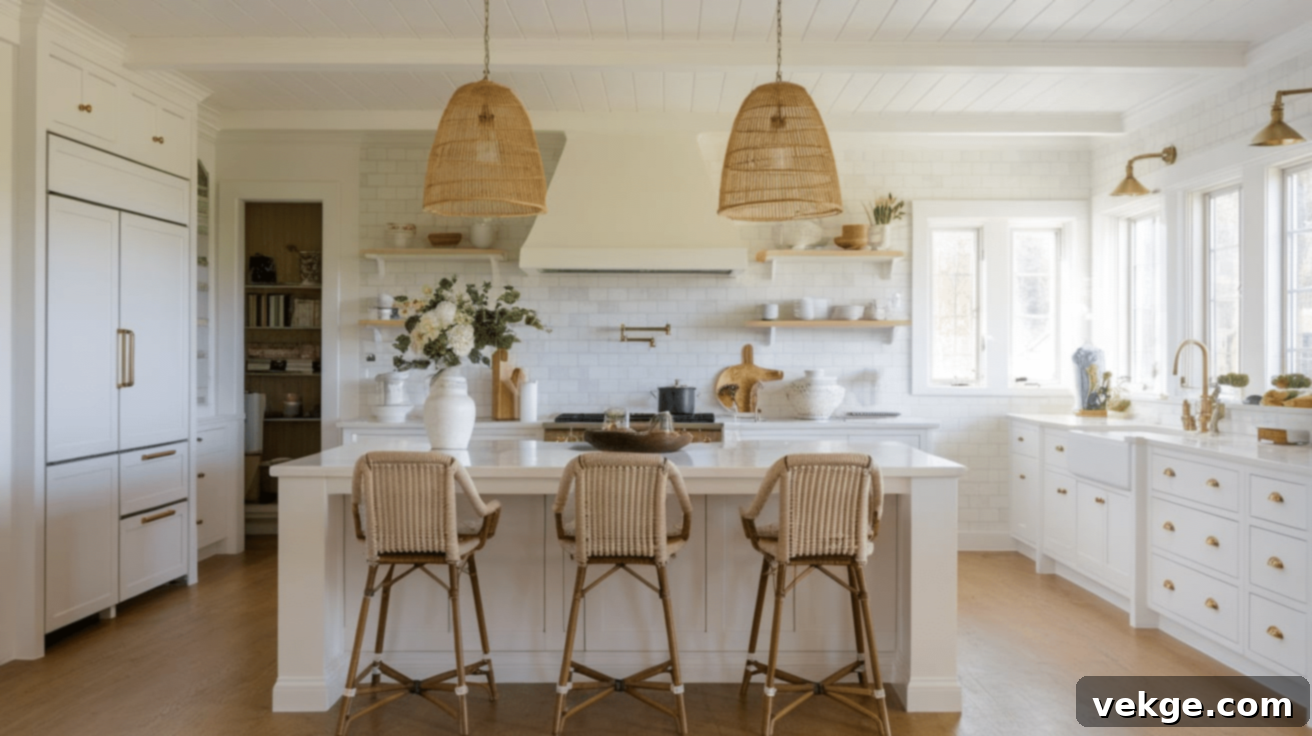
Select warm, soft lighting with natural shades to create an inviting ambiance. Rattan pendant lights or simple, elegant brass fixtures are ideal choices that complement the aesthetic beautifully. Strategically position lights to create soft pools of warmth, rather than relying solely on harsh, bright overhead lighting. As suggested by Country Living, pendant lights specifically placed over kitchen islands and sinks can serve as effective focal points while simultaneously providing essential task lighting for cooking and preparation.
5. Add Subtle Coastal Touches
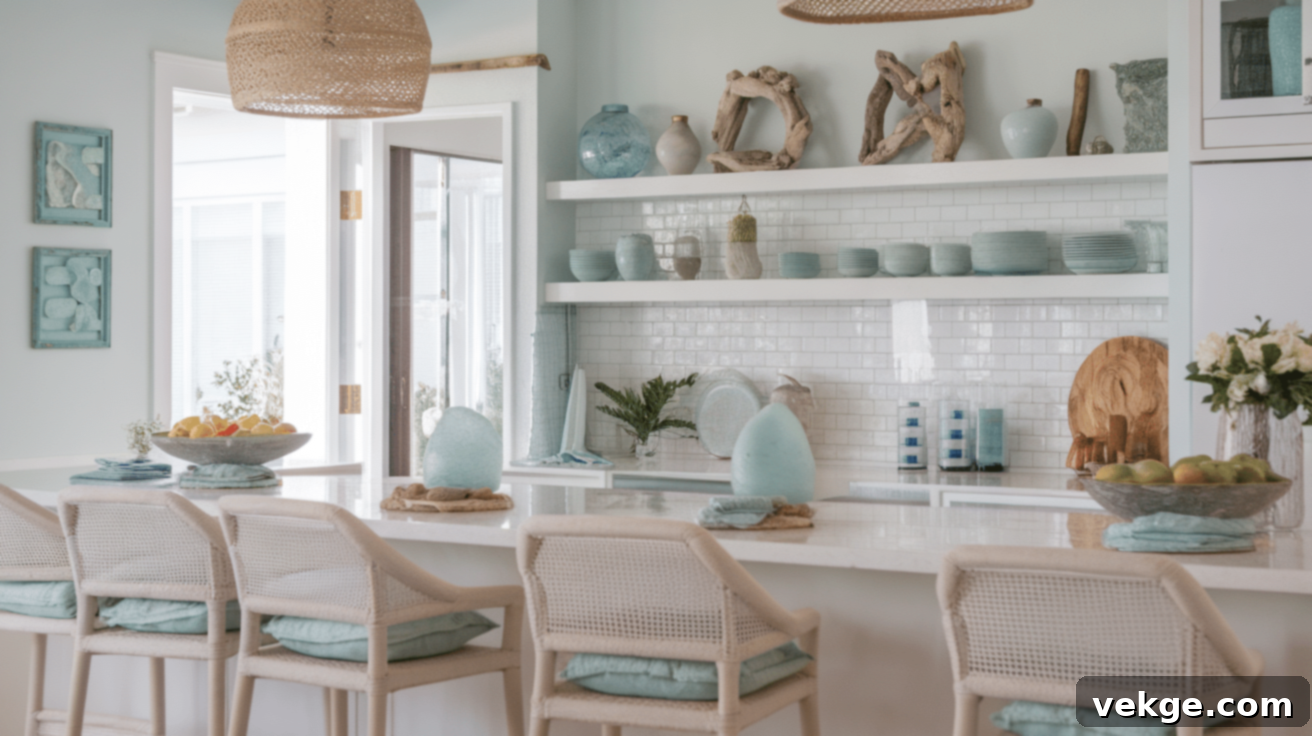
Incorporate subtle coastal elements to reinforce the theme without making the space feel overly themed or kitschy. This could include driftwood frames for artwork, delicate sea glass vases, or soft blue textiles. A mood board, such as those found on The Harper House blog, often illustrates how small, ocean-inspired touches can beautifully tie the entire look together, adding a sense of place and tranquility without being overwhelming or detracting from the overall sophistication.
6. Balance Old and New Elements
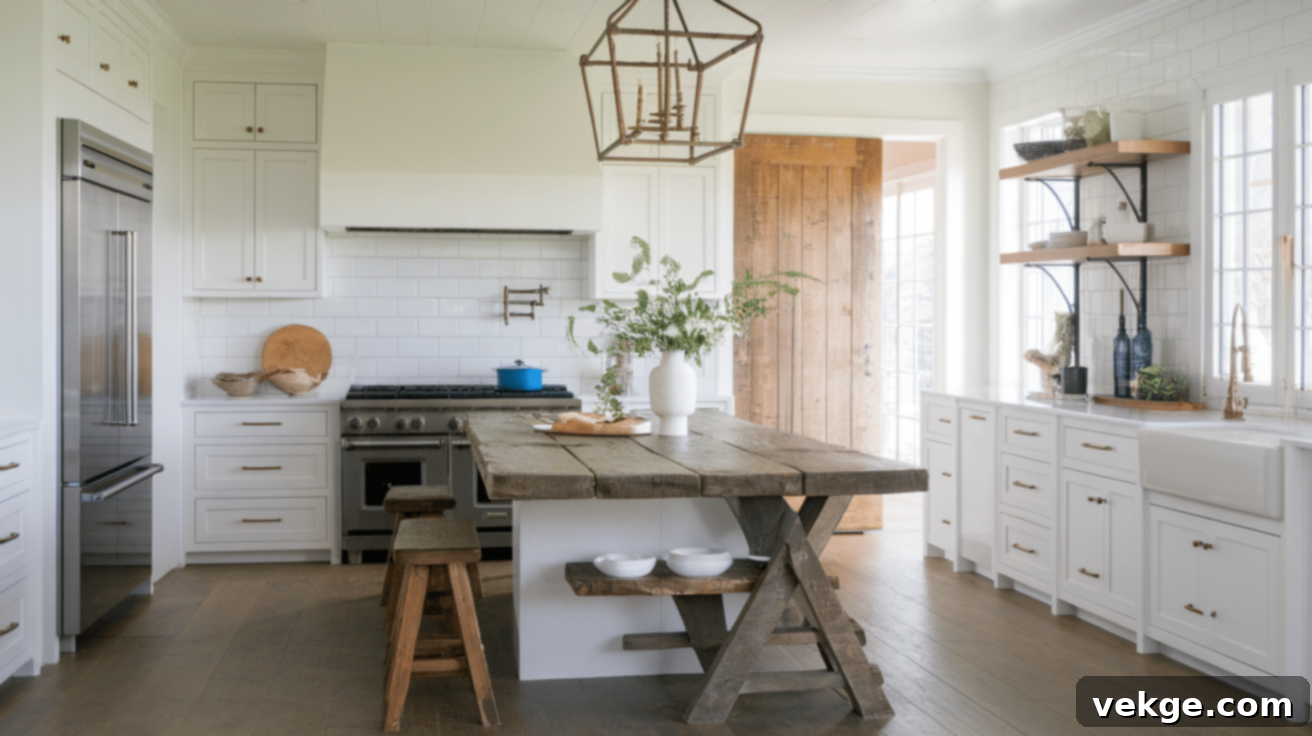
Achieve a dynamic and timeless look by pairing vintage finds with clean, modern hardware and finishes. For instance, a reclaimed wood dining table or island base can be beautifully contrasted with sleek, contemporary cabinet pulls or modern appliances to keep the overall aesthetic fresh and current. This thoughtful combination prevents the space from feeling either too dated and heavy or too cold and sterile. Actively seek out pieces with a history and distinct character that can be refreshed with new finishes or artfully combined with more contemporary elements to create a unique and harmonious design.
Budget-Friendly Tips for Your Coastal Farmhouse Kitchen
Creating your dream coastal farmhouse kitchen doesn’t have to break the bank. With a few smart strategies and a bit of DIY spirit, you can achieve this beloved look without overspending.
- Strategic Painting: Paint is one of the most transformative and cost-effective tools at your disposal. A fresh coat of white or a soft, calming blue on walls or existing cabinets can dramatically update and brighten your space, instantly evoking the coastal farmhouse feel.
- Open Shelving Advantage: Opt for open shelving instead of installing upper cabinets. This not only saves significantly on material and installation costs but also contributes directly to the light, airy aesthetic characteristic of coastal farmhouse design.
- Second-Hand Treasures: Hunt for second-hand pieces at thrift stores, antique markets, or online marketplaces. A vintage dresser can be repurposed into a charming kitchen island with a new countertop and a fresh coat of paint. Look for discounted glass containers, woven baskets, and linen textiles at home goods stores or discount retailers to add texture and functionality without a hefty price tag.
- DIY Projects: Embrace do-it-yourself projects. Many aspects of kitchen updates, such as installing a new backsplash, painting cabinets, or refreshing old hardware, are achievable for a motivated homeowner and can save substantial labor costs. Simple wall treatments like board and batten or basic shiplap are also beginner-friendly projects that add significant character.
- Smart Appliance Shopping: Look for sales on major appliances, consider floor models, or explore scratch-and-dent options for significant savings. Sometimes, slightly older models offer similar functionality at a fraction of the cost.
Maintaining Your Coastal Farmhouse Kitchen
Consistent care and maintenance are essential for preserving the charming, fresh look of your coastal farmhouse kitchen for many years to come. Establishing the right cleaning routines ensures your space remains inviting, functional, and beautiful with minimal effort.
Especially in coastal regions where salt air and humidity can be prevalent, a regular and thorough cleaning schedule becomes even more critical to protect your kitchen’s materials and finishes from premature wear. The good news is that by incorporating just a few simple habits into your weekly routine, you can effortlessly keep your kitchen looking as pristine and welcoming as the day it was completed.
- Wood Countertops: Clean weekly with mild soap and water. To prevent drying and cracking, treat them with a food-safe oil (like mineral oil or butcher block oil) every few months, or more frequently if they appear dry.
- Brass Fixtures: Wipe unlacquered brass fixtures regularly with a soft cloth and warm water to remove fingerprints and water spots. Avoid harsh chemical cleaners, as they can strip the natural finish and prevent the development of its desirable patina.
- Patina Management: Unlacquered brass is designed to develop a natural, aged patina over time, which is a key part of its appeal in this style. If you prefer to restore its original shine, you can gently clean it with a homemade paste of salt, flour, and vinegar, then rinse and dry thoroughly.
- White Surfaces: Promptly address any marks or spills on white cabinets and walls using matching paint samples for touch-ups. This prevents stains from setting in and keeps the bright, clean look intact.
- Gentle Cleaning: Always use gentle, non-abrasive cleaners on light-colored surfaces, including countertops and backsplashes. Harsh chemicals can cause discoloration or yellowing over time, diminishing the fresh aesthetic.
Conclusion: Embracing Your Coastal Farmhouse Sanctuary
The coastal farmhouse kitchen design beautifully marries beachside tranquility with rustic allure, resulting in spaces that feel both effortless and deeply inviting. By consciously selecting natural materials, embracing warm and airy color palettes, and implementing thoughtful layouts, you can create a kitchen that is not only supremely functional but also rich in character and personal charm.
Even if you’re working with a limited budget or a compact space, remember that small, intentional touches can make a significant difference. Cozy, layered lighting, carefully curated simple decor, and the choice of durable, long-lasting materials all contribute profoundly to the overall feel and longevity of your kitchen.
Ultimately, the best kitchen is one that truly resonates with you and your lifestyle. Trust your aesthetic instincts, enjoy the creative process of bringing it together, and allow your space to beautifully reflect your connection to this timeless and beloved style. With these carefully considered elements in place, your coastal farmhouse kitchen will undoubtedly become the warm, vibrant heart of your home.
Frequently Asked Questions About Coastal Farmhouse Kitchens
Can you successfully mix farmhouse and coastal styles?
Absolutely! These two styles blend exceptionally well because they share core design principles, such as a love for natural materials, a relaxed aesthetic, and an emphasis on comfort. Each style then layers its unique touches—the breezy lightness of coastal and the rustic warmth of farmhouse—to create a cohesive and charming look.
What is the ideal color palette for a coastal farmhouse kitchen?
The ideal color palette revolves around soft whites for a bright base, complemented by various shades of sea blues to evoke coastal serenity. These are balanced with sandy beiges, warm grays, and rich natural wood tones to introduce the essential country comfort and grounding elements. This combination creates a fresh yet inviting atmosphere.
How can I keep my coastal farmhouse kitchen modern yet cozy?
To achieve a balance between modern and cozy, focus on clean lines in your cabinetry and overall layout, maintaining open spaces to enhance the modern feel. Pair these elements with natural textures (like woven baskets, linen fabrics, and rustic wood), warm and layered lighting, and personal touches that make the space feel lived-in and inviting without being cluttered. Avoid overly ornate details and choose timeless, quality pieces.
